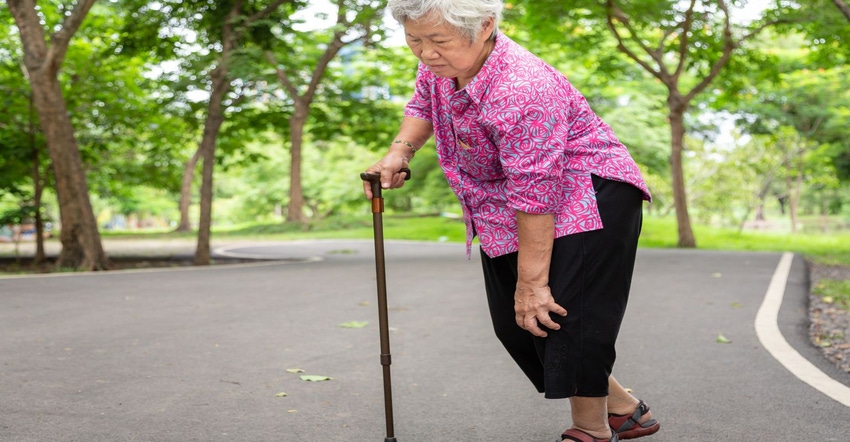Joint health is crucial for women’s health
Measuring joint health is difficult, but biomarkers could help identify temporary and longer-term cartilage and joint issues that some supplement ingredients may aid.

Over the past year, the health and wellness market has evolved at an incredible pace. According to a 2020 report from Grand View Research, the global women’s health market is expected to reach $47.8 billion by 2027. Growing awareness among women regarding nutritional requirements along with increasing consumer willingness to spend on health and beauty supplements is anticipated to drive the market expansion.
Women experience unique health issues and concerns, from pregnancy and menopause to gynecological conditions, such as uterine fibroids and pelvic floor disorders. A number of health issues affect only women and others are more common in women. What’s more, men and women may have the same condition, but the effects are different when it comes to women. For example:
• Women are more likely to die following a heart attack than men, according to a brief from the Agency for Healthcare Research and Quality.
• Women are more likely to show signs of depression and anxiety than men, per gender and stress data on the American Psychological Association website.
• Osteoarthritis (OA) affects more women than men, CDC noted in arthritis-related statistics.
• Women are more likely to have urinary tract problems due to the way the female urinary tract is structured, the National Institute of Diabetes and Digestive and Kidney Diseases reported.
Consumers, both men and women, are increasingly turning to nutritional supplements as a means of complementing a healthy lifestyle of diet and exercise to optimize health. Supplements can offer support as an increasing number of older, female consumers look to stay healthy and active, and to delay the onset of age-related degeneration and illness. It is evident, according to Nutrition Business Journal’s May 2018 “Condition Specific / Aging” issue, that one such symptom of age—deteriorating joint health—has attracted the attention of nutritional supplement marketers responsible for new product development. NBJ’s research shows supplements addressing joint health now account for approximately 4.5% of the U.S. supplement market.
Measuring joint health is somewhat difficult, and usually isn’t considered unless symptoms of joint cartilage degradation are present, such as pain or stiffness. However, biomarkers can be used to objectively determine both temporary cartilage turnover resulting from exercise, as well as excessive cartilage degradation, indicating more permanent damage to joint tissue. Some of these biomarkers, such as CTX-II (C-telopeptide fragments of type II collagen) provide a reliable indication of the level of cartilage breakdown resulting from exercise and wear and tear.1,2
A biomarker in assessing joint pathology
Cartilage is a form of avascular connective tissue found at distinct locations throughout the body. It is composed of specialized cells (chondrocytes) along with collagen fibers, water, non-collagenous proteins and proteoglycans. It is embedded within the extracellular matrix and is critical for structure and biochemical support to cells and tissues. Articular cartilage is the specific type of cartilage that surrounds joints and provides cushioning for the joints in response to the compressive forces required for movement. This type of cartilage is composed principally of type II collagen and proteoglycans, mainly in the form of aggrecan, along with glycosaminoglycans such as hyaluronic acid (HA), chondroitin sulfate and keratin sulfate.
“Osteoarthritis results from the degeneration of articular cartilage and underlying bone, leading to pain, stiffness and swelling. It is one of the most common causes of disability among older individuals,” Nena Dockery, scientific and regulatory affairs manager at Stratum Nutrition, explained. “The incidence of osteoarthritis is increasing worldwide, due to the increasing percentage of elderly in the general population, as well as to increases in the rate of obesity.3 Therefore, there is a need for more accurate ways to follow the progression of arthritis from its onset. This has led researchers to investigate several potential biomarkers, particularly those that are related to cartilage and bone turnover, with the hope that early intervention—before there is visible damage to the joint—can improve outcomes.”
A clinical review defined biomarkers as “characteristics that can be objectively measured and evaluated as indicators of normal biological processes, pathogenic processes or pharmacologic responses to therapeutic intervention.”4 Blood pressure and pulse rate are biomarkers, as are the substances measured as part of complex laboratory testing. They are the most objective, quantifiable medical signs that modern laboratory science is able to measure reproducibly. Clinical biomarkers can reflect the entire spectrum of a disease from its earliest manifestations to resolution of the disease or its terminal stages. Unfortunately, only a few biomarkers are suitable for evaluating the progression of OA, none of which are used routinely as diagnostic tools.
Dockery continued, “Though CTX-II levels don’t appear to be predictive of the actual onset of OA, elevated levels may be an early indicator of future joint problems prior to the beginning of radiographic cartilage degradation. For example, overweight persons (BMI of >25) have approximately a 25% elevated CTX-II level.5 This is a reflection of the continuous pressure placed on joints from additional weight. There also appears to be a strong inverse relationship between estrogen levels and CTX-II. As estrogen levels decline during perimenopause and particularly after menopause, CTX-II levels rise significantly. As a result, postmenopausal women may have levels substantially higher than age- and weight-matched premenopausal women.5,6 These results coincide, not only with the rising incidence of chronic rheumatic conditions such as OA, but also with the rise in joint pain reported to physicians by postmenopausal women, independent of diagnosed arthritis.”7
The use of this biomarker to determine the effects of a dietary supplement ingredient provides an additional level of confidence in the potential benefits derived from that ingredient.
The research on NEM, Stratum’s branded eggshell membrane ingredient, has incorporated CTX-II to substantiate the benefits of NEM in protecting cartilage from degradation associated with exercise. Evaluations of pain and stiffness have traditionally been the main criteria used to determine the effectiveness of supplements designed to improve joint health. The use of an objective biomarker associated with cartilage breakdown further supports NEM’s already substantiated benefits to joint health. Research that demonstrates protection and preservation of a part of the body that is often susceptible to long-term repercussions of exercise stress is a major departure from the short-term benefits often seen.
The joint health market is strong. An aging population is certainly a significant contributing factor to the growing need for joint health solutions. Increasingly more people desire to be active into middle age and beyond. Ease of movement and joint comfort are integral to an active, healthy lifestyle. But the 21st century senior citizen is not just content with being active. Many of these individuals are vibrant and busy in all aspects of their lives. Therefore, they desire a supplement regimen that is convenient, easy to maintain and takes their special needs into account.
Editor’s note: Our “Natural women’s health solutions for every stage” digital magazine features additional articles focused on the women’s health category. Click the link to access it.
Jacqueline Rizo is a content writer who specializes in B2B articles and white papers for the natural products industry on behalf of Stratum Nutrition.
References
1 Eyre DR et al. “Cross-linked telopeptides from collagen types I, II, and III in human urine.” J Bone Miner Res. 1996;11(51):5413.
2 O’Kane JW et al. “Sport-related differences in biomarkers of bone resorption and cartilage degradation in endurance athletes.” Osteoarthritis Cartilage. 2006;14(1):71-76.
3 Zhang Y and Jordan JM. “Epidemiology of Osteoarthritis.” Clin Geriatr Med. 2010;26(3):355-369.
4 Strimbu K and Tavel JA. “What are biomarkers?” Curr Opin HIV AIDS. 2010;5(6):463-466.
5 Mouritzen U et al. “Cartilage turnover assessed with a newly developed assay measuring collagen type II degradation products: influence of age sex, menopause, hormone replacement therapy, and body mass index.” Ann Rheum Dis. 2003;62:332-336.
6 Bay-Jensen AC et al. “The response to oestrogen deprivation of the cartilage collagen degradation marker, CTX-II, is unique compared with other markers of collagen turnover.” Arthritis Res Ther. 2003;11(1):R9.
7 Magliano M. “Menopausal arthralgia: Fact or fiction.” Maturitas. 2010;67(1):29-33.
About the Author(s)
You May Also Like






.png?width=800&auto=webp&quality=80&disable=upscale)